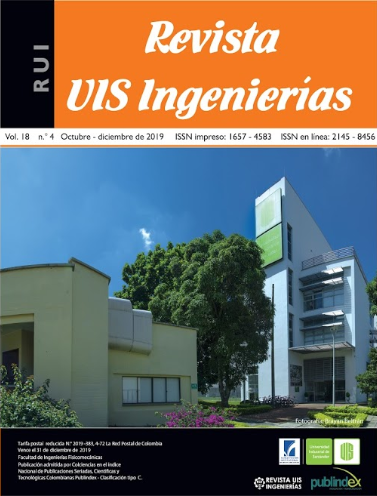Design and optimization of the mechanical structure of an anthropomorphic robotic arm developed for educational purposes
Published 2019-10-02
Keywords
- robotic arm,
- anthropomorphic arm,
- mechanical design,
- educational robotics
How to Cite
Copyright (c) 2019 Revista UIS Ingenierías

This work is licensed under a Creative Commons Attribution-NoDerivatives 4.0 International License.
Abstract
The following article presents the design and construction of the mechanical structure of an anthropomorphic robotic arm with four degrees of freedom for teaching purposes. The project started with a concept development phase obtaining six proposals designed to meet the customer needs. Subsequently, the selection of the concept to be developed was made taking as reference the product specifications. For the proposed concept were conducted seven phases of redesign that allowed achieving the proposed final design. Specifically, successive stages of simulation were carried out to analyze the dynamic response of the structure under the application of loads over time, to observe the stress state applied to each part and resize the links considering the previously defined limitations and specifications. With the results obtained, a structure was generated that meets the design specifications initially established, taking into consideration the constraints related to the servo motors to be used and the maximum load to be manipulated. Finally, the direct and inverse kinematic model of the arm is shown in addition to the final product developed.
Downloads
References
[2] J. Iqbal, Z. Khan, and A. Khalid, “Prospects of robotics in food industry,” Food Science and Technology, vol. 37, no. 2, pp. 159-165, 2017. doi: 10.1590/1678-457X.14616.
[3] E. Ceballos, M. Díaz-Rodríguez, J. Paredes, and P. Vargas, “Desarrollo de un robot de rehabilitación pasiva para la articulación de la muñeca mediante la implementación de un microcontrolador Arduino UNO,” Rev. UIS Ing, vol. 16, no. 1, pp. 59-68, 2017.
[4] Q. Feng, X. Wang, W. Zheng, Q. Qiu, and K. Jiang, “New strawberry harvesting robot for elevated-trough culture,” Int J Agric & Biol Eng, vol. 5, no. 2, pp. 1-8, 2012. doi: 10.3965/j.ijabe.20120502.001
[5] R. A. Lindemann, D. B. Bickler, B. D. Harrington, G. M. Ortiz and C. J. Voothees, "Mars exploration rover mobility development," in IEEE Robotics & Automation Magazine, vol. 13, no. 2, pp. 19-26, June 2006. doi: 10.1109/MRA.2006.1638012.
[6] A García-Cerezo et al., “Development of Alacrane: a mobile robotic assitance for exploration and rescue missions,” in IEEE International Workshop on Safety, Security and Rescue Robotics, Rome, 2007, pp. 1-6.
[7] M. Guarnieri et al., “HELIOS system: A team of tracked robots for special urban search and rescue operations,” 2009 IEEE/RSJ International Conference on Intelligent Robots and Systems, St. Louis, MO, 2009, pp. 2795-2800. doi: 10.1109/IROS.2009.5354452
[8] L. Brooks, “Adventures in liquid space: representations of the see in Disney theme parks,” in Beasts of the Deep: Sea Creatures and Popular Culture, J. Hackett and S. Harrington, Eds.: John Libbey Publishing Ltd., ch. 9, pp. 142-154.
[9] G. Balmori, “Cine y robots: del autómata al androide,” Revista de Occidente, no. 436, pp. 85-96, 2017.
[10] P. Cárdenas and R. Parreño, “Diseño e implementación del sistema de control y audio de la maqueta animada del Allosaurio para el Museo de Historia Natural Gustavo Orcés V," trabajo de fin de grado, Escuela Politécnica Nacional, Quito, 2018.
[11] N. Barrera, “Uso de la robótica educativa como estrategia didáctica en el aula,” Praxis & Saber, vol. 6, no. 11, pp. 215-234, 2015. doi: 10.19053/22160159.3582
[12] I. Moreno et al., “La robótica educativa, una herramienta para la enseñanza-aprendizaje de las ciencias y las tecnologías,” TESI, vol. 13, no. 2, pp. 74-90, 2012.
[13] C. Batz, "Diseño y construcción de un brazo robótico,” trabajo de fin de grado, Universidad de San Carlos de Guatemala, Guatemala, 2005.
[14] G. Martínez, S. Jáquez, J. Rivera, and R. Sandoval, “Diseño propio y construcción de un brazo robótico de 5 GDL,” Revista de ingeniería eléctrica, electrónica y computación, vol. 4, no. 1, pp. 1-7, 2008.
[15] M. Akshaykumar et al., “Design and development of pick and place robotics arm using PLC-Scada,” in International Conference on Current Research in Engineering, Gujarat, India, 2017, pp. 1-7.
[16] C. Riaño-Jaimes, C. Peña-Cortés, and H. Sánchez-Acevedo, “Aplicación de técnicas de desenvolvimiento de producto para el desarrollo de un robot antropomórfico,” Rev. UIS Ing., vol. 17, no. 1, pp. 21-34, 2018. doi: 10.18273/revuin.v17n1-2018002
[17] J. Jabonero, “Modelado y Análisis de un Brazo Mecánico,”, trabajo de fin de grado, Universidad Carlos III de Madrid, 2010.
[18] K. Ulrich and S. Eppinger, Diseño y desarrollo de productos, Cuarta educupib. ed. México: McGraw-Hill/ Interamericana editores, 2013.
[19] J. Braun, Libro de fórmulas, Primera edición. ed. Sachseln: Editorial maxon academy, 2013.
[20] J. Blanco, “Parametrización Denavit-Hartenberg para robots: teoría, vídeo y nueva aplicación libre,” Febrero - 2013. [Vídeo]. Disponible en: https://www.ciencia-explicada.com/2013/02/parametrizacion-denavit-hartenberg-para.html
[21] A. Jaramillo, Cinemática de Manipuladores Robóticos.2005. [En línea]. Disponible en: http://www.wag.caltech.edu/home/ajaramil/libro_robotica/cinematica.pdf

